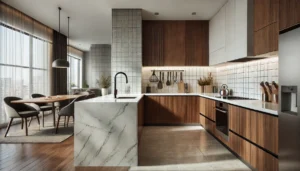When designing a kitchen, selecting the right materials is one of the most crucial decisions you’ll make. The materials you choose will impact not only the aesthetics of your kitchen but also its functionality and durability. From countertops to cabinetry, every surface in your kitchen plays a role in how the space looks and how it holds up over time. In this guide, we explore some of the best kitchen materials to help you create a beautiful and lasting kitchen that suits your lifestyle.
1. Countertops: A Balance of Style and Strength
Countertops are perhaps the most-used surface in the kitchen, so choosing a material that is both stylish and hard-wearing is key. Popular choices include:
Granite: Known for its natural beauty and resilience, granite is a classic choice. It can handle high heat and is resistant to scratches, making it perfect for a busy kitchen.
Quartz: Engineered quartz countertops offer durability, stain resistance, and a range of colors and patterns. It mimics natural stone but requires less maintenance.
Marble: If you’re aiming for luxury, marble is a stunning option. However, it’s softer than granite or quartz and can be prone to stains and scratches, so it’s best for low-traffic areas.
Butcher Block: For a warm, rustic feel, wood countertops bring charm to the kitchen. Butcher block is ideal for prepping surfaces but requires regular maintenance to prevent scratches and water damage.
2. Cabinetry: Durability with Aesthetic Appeal
Cabinetry defines the character of your kitchen, so choosing materials that fit your style and budget is important.
Solid Wood: Timeless and sturdy, solid wood cabinets can be refinished or repainted, offering a long lifespan. Oak, maple, and cherry are popular choices for a classic or traditional look.
Plywood: For a budget-friendly yet durable option, plywood cabinets are constructed from layers of wood veneer. They resist warping and cracking better than solid wood in some conditions.
MDF (Medium-Density Fiberboard): MDF is a cheaper alternative that’s smooth and easy to paint. While not as durable as wood, it’s great for modern designs with a sleek finish.
Laminate: If you’re looking for a low-maintenance and cost-effective option, laminate cabinets come in a wide range of styles and are resistant to moisture and stains.
3. Flooring: Function Meets Style
Kitchen floors endure heavy traffic, so it’s important to choose a material that can handle wear and tear while complementing your kitchen’s design.
Ceramic or Porcelain Tile: These materials are excellent for kitchens, as they are water-resistant, easy to clean, and available in countless styles. Porcelain is slightly denser than ceramic, making it more durable.
Hardwood: If you prefer a warm, timeless look, hardwood flooring is a great option. While it may require more upkeep in a kitchen setting, it can be refinished and adds value to your home.
Vinyl: For a budget-conscious choice, vinyl flooring is waterproof and easy to install. Modern vinyl options mimic the appearance of wood or stone while providing cushioning underfoot.
Natural Stone: Stone floors like slate, granite, or travertine bring an upscale look to the kitchen. However, they can be porous and may need sealing to prevent staining.
4. Backsplash: The Perfect Finishing Touch
A backsplash adds character to your kitchen and helps protect the walls from splashes and spills. Material choices include:
Subway Tile: Classic, versatile, and affordable, subway tile can be laid in various patterns to suit both modern and traditional kitchens.
Glass: For a sleek, contemporary look, glass backsplashes offer shine and are easy to clean.
Natural Stone: Stone backsplashes like marble or travertine add texture and sophistication but may require more maintenance to keep clean.
Metal: Stainless steel or copper backsplashes create an industrial or modern vibe. They’re durable and heat-resistant, ideal for areas behind the stove.
5. Sinks: A Functional Focal Point
The sink is one of the most-used areas of the kitchen, so choose a material that combines functionality and style:
Stainless Steel: A popular choice for its durability and affordability, stainless steel sinks are resistant to rust and stains. They suit modern and industrial-style kitchens.
Porcelain: Porcelain sinks offer a traditional, timeless look. They are easy to clean but can chip if heavy objects are dropped.
Granite Composite: For a sleek, durable sink, granite composite is heat-resistant and non-porous. It offers a matte finish and is available in various colors.
Conclusion:
Choosing the right kitchen materials is an essential step in creating a space that not only looks beautiful but also functions effectively in your daily life. Consider your lifestyle, maintenance preferences, and budget as you make decisions about countertops, cabinetry, flooring, and more. With the right combination of materials, your kitchen will not only withstand the demands of cooking and entertaining but will also remain a stylish centerpiece of your home for years to come.

